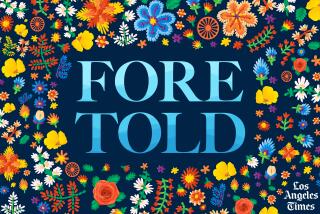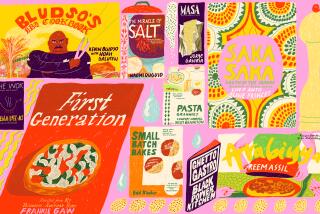Book review: ‘As Always, Julia: The Letters of Julia Child and Avis DeVoto’ by Joan Reardon
“As Always, Julia: The Letters of Julia Child and Avis DeVoto”
Joan Reardon
Houghton-Mifflin: 416 pp., $26
In 1952, a middle-aged American woman living in Paris responded to a complaint about the poor quality of American-made kitchen knives by one of her favorite magazine writers and sent him a couple of French-made ones from her neighborhood store. If you believe history turns on specific moments, you could say that impulsive act of generosity was the start of the American culinary revolution.
The housewife was Julia Child, and if her “Mastering the Art of French Cooking” and accompanying television shows weren’t the catalyst for the change in American attitudes toward cooking during the 1960s, they were certainly its most recognizable symbols. The writer was Bernard DeVoto, and though he is largely forgotten today, in the 1950s he was one of the country’s leading public intellectuals, a historian, author and longtime columnist for Harper’s magazine, when that really meant something.
DeVoto didn’t answer the letter himself, of course; that was left to his wife Avis. And for that we can be thankful because her gracious thank-you letter to Child led to a long correspondence between the two, which has now been captured in Joan Reardon’s marvelous new book “As Always, Julia.”
If Child was the mother of the modern American interest in cooking, Avis DeVoto was its midwife. She’s the one with the publishing background who steered the novice author through the perilous shoals of the book world, cheering her on when she needed it, connecting her with publishers and editors, offering astute criticism, even copy editing manuscript, testing recipes and sending American ingredients to Child overseas so she could test with the same materials her audience would be using.
In the process, what began as a polite correspondence between well-bred ladies of a certain class blossomed into a kind of frank intimacy in which Child reveals sides of herself that were known to only a few of her closest friends.
While it can pretty safely be said that there are few people in America today who haven’t heard of Child, it is also true that there are very few who actually have an idea of who she was — as apart from her cookbooks and shows.
Until last year’s movie “Julie & Julia,” in fact, it’s possible that the iconic image of Child was Dan Aykroyd’s impersonation on “Saturday Night Live,” which hilariously distilled the essence of her loopy, semi-hysterical TV personality. Nora Ephron’s marvelous movie revealed a bit more of the person behind the caricature, but ultimately, it was just a tease compared with what’s found in Reardon’s book.
The real Child was infinitely more complex than her popular image, and much more interesting. Through the letters we see her grow as a cook and as an author. She begins tentatively, but her instincts are spot-on. She tests and retests, measuring, weighing and timing everything repeatedly to make her recipes as accurate as they could possibly be. She sends early drafts of them to friends in the States for testing and takes their comments seriously. Most of them anyway, but beneath the clubwoman gentility, we get a sense of steel and drive when it comes to points she believes in.
And make no mistake, Child’s book didn’t come easily. It took more than 10 years from the time she started work on it until the eventual publication in 1961 (when she was almost 50). And along the way it passed through two other publishers before finally finding a home.
Certainly the worst moment had to be in 1959, when the finished manuscript was rejected by one publisher for being too encyclopedic. “So I am deeply depressed, gnawed by doubts and feel that all our work may just lay a big rotten egg,” Child mourned. “But I would hate to take what I consider to be the guts out of our book. I suppose the only thing to do is to go along as we have been....”
Just as interesting as the behind-the-scenes nuts-and-bolts on this culinary landmark is the far subtler picture that is painted of these two women, the times in which they were living, and the friendship that grew between them.
What begins as a very polite “Dear Mrs.” very quickly becomes “Dear” and then “Dearest Friend.” As the formality passes, we witness a friendship, and eventually a sisterhood being born.
Despite the fact that they were raised on opposite coasts, both women had roots in upper-middle-class New England (Child was from Pasadena, but her family was old Massachusetts, and she attended Smith College). In their early correspondence, they discover several common friendships, and a shared sort of bien-pensant political liberalism that, while common among their Ivy League friends, was distinctly at odds with the mood of the country — and particularly with Child’s own family.
“I am, of course, ‘persona traitoria’ to my family in California, who are Old Guard Republicans of the blackest and most violently Neanderthal stripe,” Child wrote. “My nice step-mother wrote me the other day saying please not to write anything more to my father about either politics or Charlie Chaplin, as it upsets him too much.”
Indeed, some of the most striking passages in the letters describe the level of McCarthy-era paranoia.
“I must warn you to be careful what you say about McCarthy,” DeVoto wrote in 1953. “B[ernard] and I can say what we damn well please, and we do. But Paul [Child, Julia’s husband and a federal employee] has a job. And he could lose it. The situation is just as bad as that. I’m beginning to realize what it must feel like to live in a police state.”
In fact, Paul Child was called back to Washington to face questioning, though he did manage to keep his job.
Through everything that transpired in those 10 years — successes and failures, news and gossip, births and deaths — their friendship deepened. Some of the letters take on the resonance of a plainsong kind of poetry. After Bernard DeVoto died quite suddenly while out of town, his widow wrote: “I don’t feel shock so much as complete emptiness … it was if he had stepped down an open manhole. I feel he just went off into space. And I feel in the most curious way cheated of all that anguish. Can’t quite describe what I feel.”
Though “Mastering the Art of French Cooking” was definitely Child’s own work, along with her co-authors Simone Beck and Louisette Bertholle (who helped in varying and occasionally exasperating ways), there’s no mistaking how much she came to rely on Avis DeVoto’s advice. It was DeVoto who guided Child from the small publisher she had started with to the much more commercial Houghton-Mifflin, and then years later after they rejected the book, she hand-carried it to friends at Alfred A. Knopf, where it was eventually published.
In fact, at one point Child had proposed dedicating the book to her. “That you have taken all this time and devotion and energy to promote something by people you only know through two pieces of cutlery, rustable at that.... But how nice it is that one can come to know someone just through correspondence, and become really passionate friends.”
More to Read
The biggest entertainment stories
Get our big stories about Hollywood, film, television, music, arts, culture and more right in your inbox as soon as they publish.
You may occasionally receive promotional content from the Los Angeles Times.











